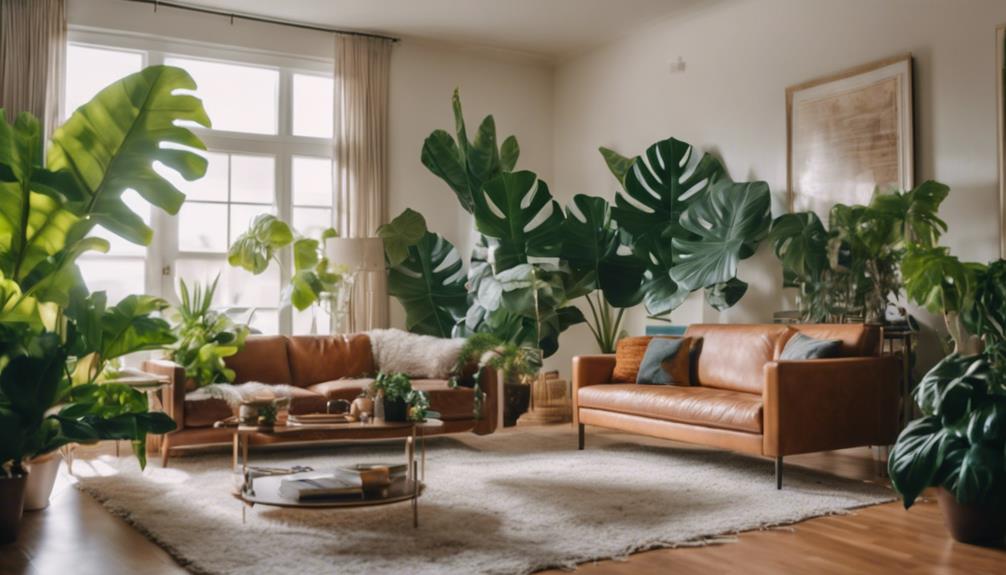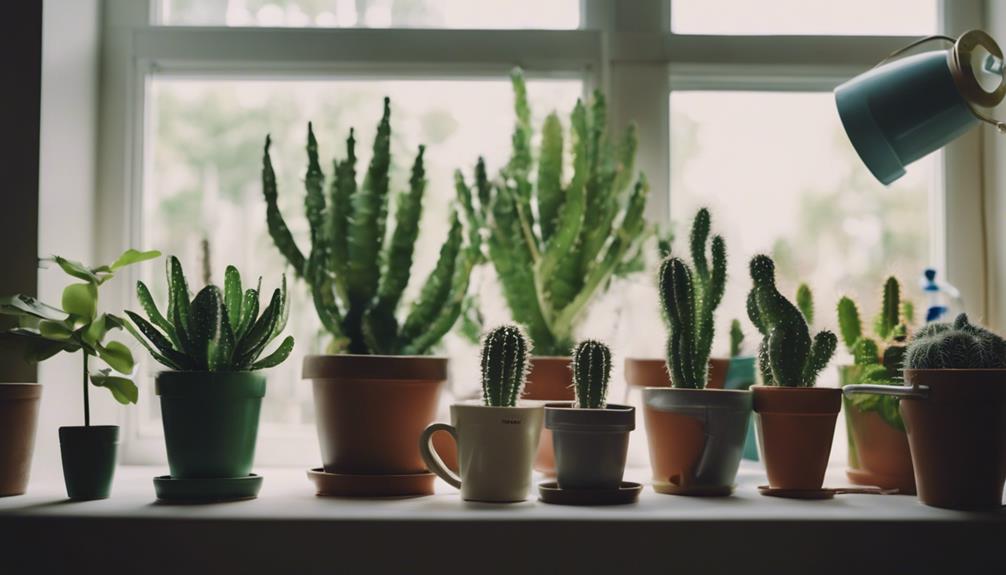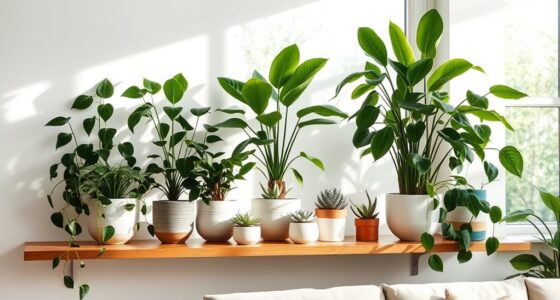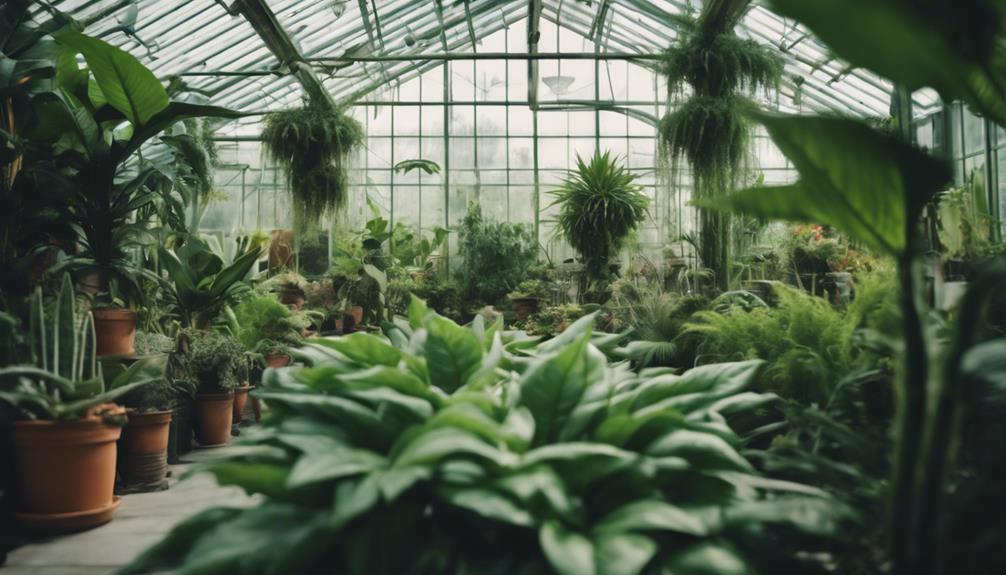To start a hydroponic herb garden on a tight budget, repurpose household containers like plastic bins or bottles, ensuring they’re clean and have drainage holes. Use inexpensive or homemade nutrient solutions and support plants with small, recycled containers. Add affordable air pumps or manually circulate water to keep roots oxygenated. Place your setup near bright windows or use low-cost grow lights, and stay attentive to water and nutrient levels. Keep exploring for more tips to grow lush herbs affordably.
Key Takeaways
- Repurpose recycled containers like plastic bins or bottles, ensuring proper drainage and clean conditions.
- Use household ingredients or homemade solutions for nutrients, avoiding expensive commercial fertilizers.
- Support herbs with small recycled pots or cups, arranging them for optimal growth and accessibility.
- Incorporate affordable air or submersible pumps, or manually aerate water to maintain oxygen levels.
- Place your setup near sunlight or use inexpensive grow lights, and regularly monitor water and nutrient levels.
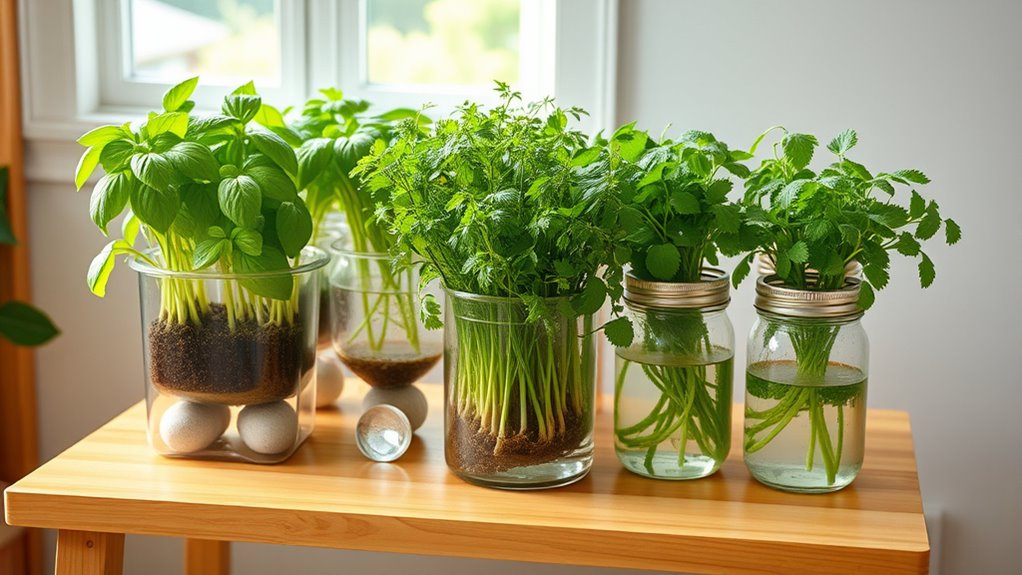
Hydroponic herb gardens offer a simple and efficient way to grow fresh herbs indoors or outdoors without soil. If you’re working with a tight budget, setting up your own hydroponic system can be affordable and rewarding. A DIY setup doesn’t have to be complicated or expensive; with a little creativity, you can create a functional garden using everyday materials. Start by choosing a container that can hold water and support your plants—old plastic bins, buckets, or even repurposed containers work well. Make sure it’s clean and has drainage holes or can be drilled easily.
Create a simple, affordable hydroponic herb garden with recycled containers and minimal setup.
Once you have your container, you’ll need a way to support your herbs. You can use small pots, cups, or even cut-up plastic bottles. To keep costs low, consider using recycled materials or items you already have lying around. Next, you’ll want to set up a system to deliver nutrients directly to your plants. This involves creating a nutrient solution, which is essential for healthy growth since there’s no soil to provide nutrients. You can buy pre-made solutions at garden centers or make your own using household ingredients like fish emulsion, compost tea, or diluted fertilizer. Avoid overfeeding; start with a weak solution and adjust as needed based on how your herbs respond.
To keep the nutrient solution circulating, you might add an air pump or small submersible pump, which can often be found cheaply online or at thrift stores. These help oxygenate the water, preventing root rot and ensuring your herbs get enough oxygen. If you want to keep things super simple, you can even manually top up and stir the solution regularly, though a small pump makes maintenance easier. Light is vital for your herbs to thrive; place your DIY hydroponic setup near a sunny window or set up inexpensive grow lights if natural light is limited. Regular monitoring of water levels and nutrient strength helps prevent deficiencies and keeps your herbs growing robustly. Additionally, understanding the importance of color accuracy in your growing environment can help you optimize light conditions for better herb development.
Starting with a DIY setup also means you can experiment with different herbs and tweak your system as you learn what works best for your space and budget. You don’t need expensive equipment or complex systems—your resourcefulness is your best tool. With some patience and a little effort, you’ll be harvesting fresh herbs from your homemade hydroponic garden in no time. This approach not only saves money but also gives you the satisfaction of building something from scratch, making your gardening journey both affordable and fulfilling.
Frequently Asked Questions
What Are the Best Herbs for Beginner Hydroponic Gardens?
When starting your hydroponic garden, choose herbs with easy herb flavor profiles like basil, mint, and lettuce. These herbs thrive and grow quickly, making them perfect for beginners. Some hydroponic gardening myths suggest you need fancy equipment, but you can start simple and still succeed. Focus on proper lighting and nutrients, and you’ll enjoy fresh herbs in no time while debunking common myths about hydroponic gardening.
How Often Should I Change the Nutrient Solution?
You should change your nutrient solution every 2 to 3 weeks to maintain ideal growth. During this time, regularly check the pH balancing to keep it between 5.5 and 6.5, and monitor nutrient concentration levels to prevent deficiencies or overfeeding. If you notice roots turning brown or plant health declining, it’s a sign to replace the solution sooner. Consistent maintenance ensures your herbs thrive.
Can Hydroponic Herb Gardens Be Indoor or Outdoor?
Your hydroponic herb garden can thrive both indoors and outdoors, and it’s like having a green paradise wherever you place it! Indoors, you’ll need good indoor lighting to mimic sunlight, while outdoors, guarantee proper drainage to prevent overwatering. Both options work beautifully, giving you fresh herbs year-round. Just remember, indoors you control the environment; outdoors, nature does the work. Your choice depends on space, climate, and your gardening vibe!
What Are Common Pests or Problems in Hydroponic Herb Gardens?
You should watch out for common pests like aphids, spider mites, and whiteflies, which can harm your herbs. Pest identification helps you spot issues early. Also, be aware of common diseases such as root rot and mold that thrive in humid conditions. Regularly check your plants, maintain proper airflow, and keep everything clean to prevent these problems from taking hold and ruining your hydroponic herb garden.
How Do I Prevent Algae Growth in My Hydroponic Setup?
To prevent algae growth in your hydroponic setup, focus on algae control by reducing light exposure to nutrient-rich water. Use opaque containers or cover tanks to block light, and make certain your system is sealed tightly. Proper light management is key—avoid direct sunlight and use grow lights carefully. Regularly clean your system, check for leaks, and maintain proper nutrient levels to minimize algae and keep your plants healthy.
Conclusion
With just a little ingenuity and effort, you can create a thriving herb garden without breaking the bank. It’s a gentle reminder that beauty and freshness can flourish even on a modest budget. Each small step you take nurtures not only your herbs but also your spirit of resourcefulness. So, embrace the journey, and let your humble setup blossom into a fragrant, living demonstration to your care and creativity.


